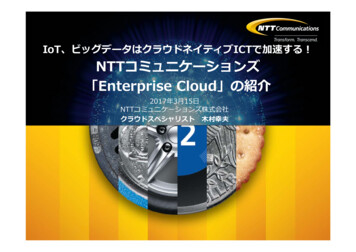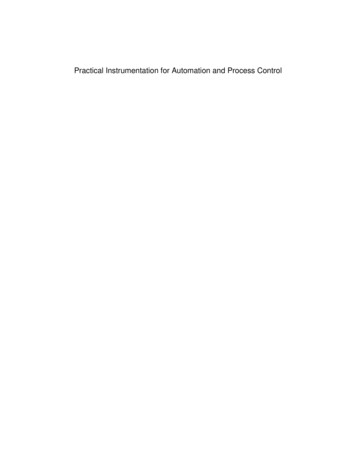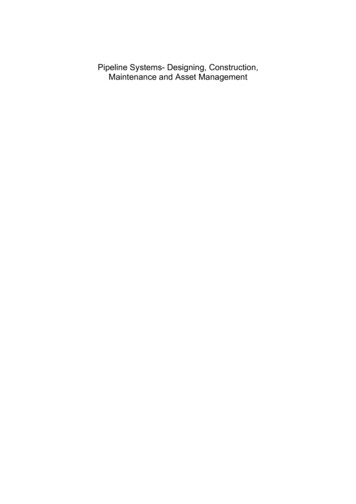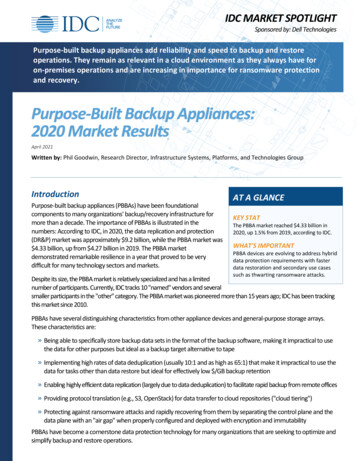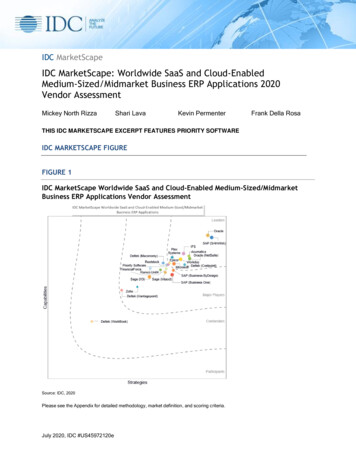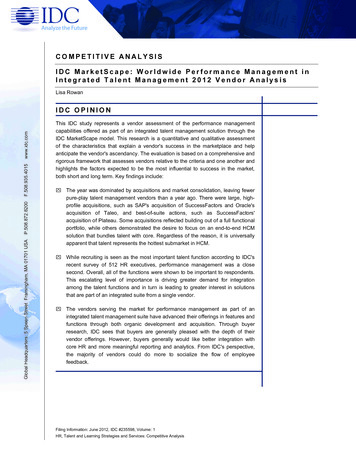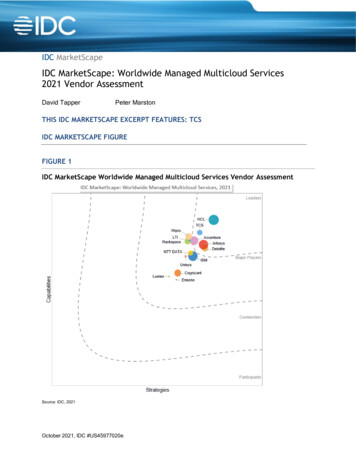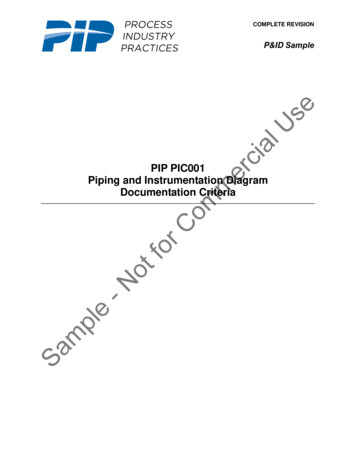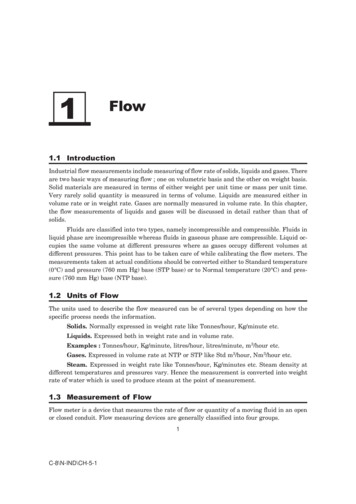
Transcription
1Flow1.1 IntroductionIndustrial flow measurements include measuring of flow rate of solids, liquids and gases. Thereare two basic ways of measuring flow ; one on volumetric basis and the other on weight basis.Solid materials are measured in terms of either weight per unit time or mass per unit time.Very rarely solid quantity is measured in terms of volume. Liquids are measured either involume rate or in weight rate. Gases are normally measured in volume rate. In this chapter,the flow measurements of liquids and gases will be discussed in detail rather than that ofsolids.Fluids are classified into two types, namely incompressible and compressible. Fluids inliquid phase are incompressible whereas fluids in gaseous phase are compressible. Liquid occupies the same volume at different pressures where as gases occupy different volumes atdifferent pressures. This point has to be taken care of while calibrating the flow meters. Themeasurements taken at actual conditions should be converted either to Standard temperature(0 C) and pressure (760 mm Hg) base (STP base) or to Normal temperature (20 C) and pressure (760 mm Hg) base (NTP base).1.2 Units of FlowThe units used to describe the flow measured can be of several types depending on how thespecific process needs the information.Solids. Normally expressed in weight rate like Tonnes/hour, Kg/minute etc.Liquids. Expressed both in weight rate and in volume rate.Examples : Tonnes/hour, Kg/minute, litres/hour, litres/minute, m3/hour etc.Gases. Expressed in volume rate at NTP or STP like Std m3/hour, Nm3/hour etc.Steam. Expressed in weight rate like Tonnes/hour, Kg/minutes etc. Steam density atdifferent temperatures and pressures vary. Hence the measurement is converted into weightrate of water which is used to produce steam at the point of measurement.1.3 Measurement of FlowFlow meter is a device that measures the rate of flow or quantity of a moving fluid in an openor closed conduit. Flow measuring devices are generally classified into four groups.1C-8\N-IND\CH-5-1
2INDUSTRIAL INSTRUMENTATIONThey are :1. Mechanical type flow meters. Fixed restriction variable head type flow metersusing different sensors like orifice plate, venturi tube, flow nozzle, pitot tube, dall tube, quantity meters like positive displacement meters, mass flow meters etc. fall under mechanicaltype flow meters.2. Inferential type flow meters. Variable area flow meters (Rotameters), turbineflow meter, target flow meters etc.3. Electrical type flow meters. Electromagnetic flow meter, Ultrasonic flow meter,Laser doppler Anemometers etc. fall under electrical type flow meters.4. Other flow meters. Purge flow regulators, Flow meters for Solids flow measurement, Cross-correlation flow meter, Vortex shedding flow meters, flow switches etc.The working principle construction, calibration etc. of the above flow meters will bediscussed in the following sections.1.4 Mechanical FlowmetersFixed restriction variable head type flow meters using different sensors like orifice plate, venturitube, flow nozzle, pitot tube, dall tube, quantity meters like positive displacement meters,mass flow meters are the popular types of mechanical flow meters.1.4.1 Theory of Fixed Restriction Variable Head Type FlowmetersIn the variable head type flow meters, a restriction of known dimensions is generallyintroduced into pipeline, consequently there occurs a head loss or pressure drop at the restriction with increase in the flow velocity. Measurement of this pressure drop is an indication ofthe flow rate.V2A2A1V1Z1Z2P1P2Datum lineFig. 1.1 Schematic representation of a one dimensional flow system with a restrictionC-8\N-IND\BOOK1-1
3FLOWHead—type flow measurement derives from Bernoulli’s theorem which states that in aflowing stream, the sum of the pressure head, the velocity head and the elevation head at onepoint is equal to their sum at another point in the direction of flow plus the loss due to frictionbetween the two points. Velocity head is defined as the vertical distance through which aliquid would fall to attain a given velocity. Pressure head is the vertical distance which acolumn of the flowing liquid would rise in an open-ended tube as a result of the static pressure.In general, a one—dimensional flow system is assumed. The schematic representationof such a system with a restriction in the pipeline is shown in Fig. 1.1.1.4.1.1 Flow of Incompressible Fluids in PipesSection-1 is the position of upstream tap and Section-2 that for downstream. The termsT, A, ρ, V, P and Z represent Temperature, Area, Density, Stream velocity, Pressure and Centralline elevation respectively. If this elevation is quite small such that Z2 – Z1 is negligible, theBernoulli’s equation for an incompressible (ρ1 ρ2) frictionless and adaptive flow is written asP1 V12 P2 V2 2 2g2gρρ.(1.1)where g acceleration due to gravity, givingV2 2 ρ[1 – (V1/V2)2]2gThe continuity equation for this type of flow isP1 – P2 .(1.2)Q A2V2 A1V1where Q volume flow rate in.(1.3)m3/sec.Combining equations (1.2) and (1.3) and manipulating, one getsQ A2V2 where Mva 1F A IJ1– GHA K2LM[1 (A /A ) ] MNA2212OPPQ2 g (P1 P2 ) A 2 M vaρ2 gh.(1.4) Velocity approach factor21h P1 – P2 Differential head.ρThis is equation for the ideal volume flow rate.For actual flow conditions with frictional losses present, a correction to this formula isnecessary. Besides, the minimum area of flow channel occurs not at the restriction but at somepoint slightly downstream, known as the ‘Venacontracta’. This in turn depends on the flowrate. While the tapping positions are fixed, the position of maximum velocity changes withchanging flow rate.The basic equations are :V K1Q K1AW K1AC-8\N-IND\BOOK1-1.(1.5)hh.(1.6)hP.(1.7)
4whereINDUSTRIAL INSTRUMENTATIONV Velocity of FluidQ Volume flow rateW Mass flow rate.A Cross-sectional area of the pipe.h differential head between points of measurement.ρ density of the flowing fluidK1 Constant which includes ratio of cross-sectional area of pipe to cross-sectionalarea of nozzle or other restrictions.1.4.1.2 β RatioMost variable head meters depend on a restriction in the flow path to produce a changein velocity. For the usual circular pipe, the Beta ratio is the ratio between the diameter of therestriction and the inside diameter of the pipe.β d/Dwhere.(1.8)d diameter of the restrictionD inside diameter of the pipe.1.4.1.3 Reynolds NumberIn practice, flow velocity at any cross section approaches zero in the boundary layeradjacent to the pipe wall and varies across the diameter. This flow velocity profile has a significant effect on the relationship between flow velocity and pressure difference developed in thehead meters.Sir Osborne Reynolds proposed single, dimensionless ratio known as Reynolds number,as a criterion to describe this phenomenon. This number, Re, is expressed asRe whereρVDµ.(1.9)V velocityD Diameter of the pipelineρ density andµ absolute viscosity.Reynolds number expresses the ratio of inertial forces to viscous forces. At a very lowReynolds number, viscous forces predominate and inertial forces have little effect. At highReynolds number, inertial forces predominate and viscous effects become negligible.1.4.1.4 Discharge Coefficient (Cd)Discharge coefficient, C is defined as the ratio between actual volumetric flow rate andideal volumetric flow rate.Cd whereqactualqidealqactual Actual volumetric flow rateqideal Ideal volumetric flow rate. (Theoretical)C-8\N-IND\BOOK1-1.(1.10)
5FLOW1.4.1.5 Flow Coefficient (K)K Cd/ 1 β 4where.(1.11)K Flow coefficientCd discharge coefficientβ ratio of diameters d/Dwhere 1/ 1 β 4 is known as velocity approach factor (that is velocity at section-A1) Mva. K Cd . MvaFig. 1.2 Orifice and Pressure-Differential MeasurementMeasuring fluid flow with an orifice and differential pressure manometer as shown inFig. 1.2, requires that the effect of the fluid over the manometer liquid be taken into account.Furthermore, the pressure differential at the orifice is usually expressed in liquid-columnheight. ThenP1 – P2 (ρm – ρf)hwhere.(1.12)h differential at restriction, liquid column heightρm weight density of manometer fluidρf weight density of fluid over the manometer fluid.Finally if the flow rate is to be converted at the control room temperature at which thefluid density is ρs, then from equations (1.4), (1.11) and (1.12).Q KA2C-8\N-IND\BOOK1-12gh (ρ m ρ f )ρ.ρ KA2ρs2 ghρ (ρ m ρ f )ρs.(1.13)
6INDUSTRIAL INSTRUMENTATION1.4.1.6 Flow of Compressible Fluids in PipesIf the fluid is compressible, a flow rate can be obtained if the gas is considered ideal andthe flow is considered adiabatic.The relation between pressure and velocity for flow of a compressible fluid through anorifice can be found from the law of conservation of energy as employed in thermodynamics.Assuming no heat flow to or from the fluid and no external work done on or by the fluid andneglecting the very small datum level difference (Z1 – Z2), we haveV2 2V2 JE2 P1v1 1 JE12g2gE internal molecular energy of fluidP2v2 where.(1.14)J work equivalent of heatv Specific volume of fluidEmploying the definition of enthalpy H givesV22 – V12 2gJ (H1 – H2).(1.15)For an ideal gas and if specific heats are constant,KRT [1 – (P2/P1)(K–1)/K]J (K 1) 1K ratio of specific heats Cp/CvH1 – H2 where.(1.16)R gas constant for a given gasT absolute temperature.From the equation of continuity (conservation of mass).W A 2 V2 A 1 V1 v2v1.(1.17)where W is the mass flow rate.Combining the foregoing equations and manipulating, we get the relation for flow ofideal gases.W A1β22 gK P1 (P2 /P1 ) 2 / K (P2 /P1 ) (K 1) / K.K 1 v11 β 4 (P2 /P1 ) 2 / K.(1.18)Manometer, however, measures (P1 – P2) and not P2/P1, therefore, it is necessary toconvert the equation (1.18) such that W is a function of (P1 – P2). Write P2/P1 1 – x such thatx 1 – (P2/P1). In general, for gas flow P2/P1 is very close to unity such that x is very close tozero.(P2/P1)2/K 1 – (2/K) x 1 – (2/K) (2/K) (P2/P1)Hence,(P2/P1)(K 1/K) 1 – (K 1/K) (K 1/K) (P2/P1).(1.19)using equation (1.19), equation (1.18) is modified tow CA1β2where C is the discharge coefficient.C-8\N-IND\BOOK1-12 g (P1 P2 )v1 [1 β 4 (P2 /P1 )]2 / k.(1.20)
7FLOWFor quick calculation an additional parameter known as the rational expansion factor Yis defined asCompressible flow rate (mass)Incompressible flow rate (mass)By determining the mass flow rate for incompressible fluids and multiplying with Y,flow rate for compressible fluids can be found out and Y can be easily shown asY Y 1 β41 β 4 (P2 /P1 ) 2 / K.K (P2 /P1 ) 2 / K 1 (P2 /P1 ) ( K – 1)/ K.K 11 (P2 /P1 ).(1.21)Instead of calculating Y from the equation (1.21) empirical relations are suggested whichgive good results for limited (P2/P1) values, such as 0.8 1.0.Y 1 – [0.41 0.35β4] (P1 – P2/KP1).(1.22)When the gas contains moisture, as further correction is required to account correctlyfor the density of the vapour.Pv {(S v /S) 1}PPv Vapour pressure (abs)M 1 where.(1.23)Sv Vapour specific gravity referred to air at the same pressure and temperatureS Specific gravity of the gasP Pressure of the gas.The specific volume of the gas may be found fromyRTPy compressibility factor.(1.24)V whereR gas constantThe flow equation for gases isQ KA2YwherevbMb2 gM 1 (ρ m ρ f ) hv1.(1.25)vb Specific volume of gas at base conditionv1 specific volume of gas at upstream conditionsM1 Moisture factor at upstream conditionsMb Moisture factor at base conditions.1.4.2 Orifice Flow MeterAn Orifice flow meter is the most common head type flow measuring device. An orificeplate is inserted in the pipeline and the differential pressure across it is measured.1.4.2.1 Principle of OperationThe orifice plate inserted in the pipeline causes an increase in flow velocity and a corresponding decrease in pressure. The flow pattern shows an effective decrease in cross sectionbeyond the orifice plate, with a maximum velocity and minimum pressure at the venacontracta.C-8\N-IND\BOOK1-1
8INDUSTRIAL INSTRUMENTATIONThe flow pattern and the sharp leading edge of the orifice plate (Fig. 1.3) which produces it are of major importance. The sharp edge results in an almost pure line contact between the plate and the effective flow, with the negligible fluid-to-metal friction drag at theboundary.Fig. 1.3 Flow pattern with orifice plate1.4.2.2 Types of Orifice PlatesThe simplest form of orifice plate consists of a thin metal sheet, having in it a squareedged or a sharp edged or round edged circular hole.There are three types of orifice plates namely1. Concentric2. Eccentric and3. Segmental type.Fig. 1.4 shows two different views of the three types of Orifice plates.(a) ConcentricC-8\N-IND\BOOK1-1(b) Eccentric(c) Segmental
9FLOW(a) Concentric(b) Eccentric(c) SegmentalFig. 1.4 Sketch of orifices of different typesThe concentric type is used for clean fluids. In metering dirty fluids, slurries and fluidscontaining solids, eccentric or segmental type is used in such a way that its lower edge coincides with the inside bottom of the pipe. This allows the solids to flow through without anyobstruction. The orifice plate is inserted into the main pipeline between adjacent flanges, theoutside diameters of the plate being turned to fit within the flange bolts. The flanges are eitherscrewed or welded to the pipes.1.4.2.3 Machining Methods of OrificesMachining of the orifice plate depends on its specific use. Three types shown in Fig. 1.5explains the machining methods.αdDFtType-1Type-2Type-3Fig. 1.5 Machining Methods of OrificesTypes 1 and 2 are very commonly used and F is known as the plater. These two areeasier to manufacture and are easily reproducible while type 3 is not. Thickness t as chosen towithstand the buckling forces. Type 1 has also reduced pressure losses. Type 3, known as thequadrant edged orifice, is used for more viscous fluids where corrections for low Reynoldsnumber and viscosity are necessary.C-8\N-IND\BOOK1-1
10INDUSTRIAL INSTRUMENTATION1.4.2.4 Materials Chosen For OrificesThe material chosen for orifice plate is of any rigid material of non-rusting and noncorrodible. It is vital that the material should not corrode in the fluid being metered. Otherwise the edge of the orifice will get damaged to a sufficient extend to interfere with the character of the flow and the accuracy of the measurement. We should choose a material whosecoefficient of Thermal expansion is known. The common materials used are Stainless steel,Monel, Phosphor bronze, Glass, Ceramics, Plastics, Brass, Copper, Aluminium and Tantalum.1.4.2.5 Position of Taps in OrificeThe area of the fluid stream continues to contract after the stream has left the orificeand it has a minimum diameter at the venacontracta. The pressure of the fluid thereforecontinue to fall after leaving the orifice.There is a slight fall in pressure in the approach section and the static pressure is at aminimum about one pipe diameter before the orifice plate. The pressure of the fluid then risesnear the face of the orifice. There is then a sudden fall of pressure as the fluid passes throughthe orifice, but the minimum pressure is not attained until the venacontracta is reached.Beyond the venacontracta, there is a rapid recovery in the static pressure.Owing to friction and dissipation of energy in turbulence, the maximum downstreampressure is always lesser than the upstream pressure. The pressure loss so caused dependsupon the differential pressure and increases as the orifice ratio decreases for a given rate offlow.The differential pressure obtained with an orifice plate will also depend upon the positionof the pressure taps. The points to be observed while locating the taps are :(a) they are in the same position relative to the plane of the orifice for all pipe sizes.(b) the tap is located at a position for which the slope of the pressure profile is at least,so that slight errors in tap position will have less effort on the value of the observed pressure.(c) the tap location in the installation is identical with that used in evaluation of thecoefficients on which the calculation is based.Fig. 1.6 shows the location of Pressure taps with Orifice plate. – ––Diagram of standard orificeplate with annular chambersDiagram of standard orificeplate with single tapsDiagram of orifice plate withpressure taps similar tostandard typeFig. 1.6 Location of Pressure taps with Orifice plateC-8\N-IND\BOOK1-1
11FLOWThere are five common locations for the differential pressure taps :(i) Flange taps(ii) Venacontracta taps(iii) Radius taps(iv) Full flow or pipe taps and(v) Corner taps.(i) Flange taps. They are predominantly used for pipe sizes 50 mm and larger and thecenterlines are 25 mm from the orifice plate surface. They cannot be used for pipe size of lessthan 35 mm diameter. Since the venacontracta may be closer than 25 mm from the orificeplate.(ii) Venacontracta taps. These taps use an upstream tap located one pipe diameterupstream of the orifice plate, and a downstream tap located at the point of minimum pressure.Venacontracta taps normally limited to pipe size 150 mm or large depending upon the flangerating and dimensions.(iii) Radius taps. d1 D and d2 1/2 D. These are similar to venacontracta taps exceptthat downstream tap is located at one half pipe diameter. These are generally consideredsuperior to the venacontracta tap because they simplify the pressure tap location dimensionsand do not vary with changes in orifice β ratio.(iv) Pipe taps. Pipe taps are located 2.5 pipe diameters upstream (d1 2.5D) and 8diameters downstream (d2 8D) from the orifice plate. Because of the distance from the orifice, exact location is not critical, but the effects of pipe roughness, dimensional inconsistenciesand so on are more severe.(v) Corner taps. These taps are similar in many respects to flange taps, except thatthe pressure is measured at the ‘Corner’ between the orifice plate and the pipe wall. These areused for diameters of less than 50 mm.1.4.3 Venturi TubesVenturi tubes are differential pressure producers, based on Bernoulli’s Theorem. General performance and calculations are similar to those for orifice plates. In these devices, there is acontinuous contact between the fluid flow and the surface of the primary device.1.4.3.1 Classic Venturi Construction : [Long Form Venturi]The classic Herchel Venturi tube is given in Fig. 1.7.It consists of a cylindrical inlet section equal to the pipe diameter ; a converging conicalsection in which the cross sectional area decreases causing the velocity to increase with acorresponding increase in the velocity head and a decrease in the pressure head ; a cylindricalthroat section where the velocity is constant so that the decreased pressure head can be measured ; and a diverging recovery cone where the velocity decreases and almost all of the originalpressure head is recovered. The unrecovered pressure head is commonly called as head loss.C-8\N-IND\BOOK1-1
12INDUSTRIAL INSTRUMENTATIONCylindricalinletConvergententrance ThroatDivergent outletAnnular chambersClassic Herschel venturi with annular pressure chambersFig. 1.7 Classic Long form VenturiThe classic venturi is always manufactured with a cast iron body and a bronze or stainless steel throat section. At the midpoint of the throat, 6 to 8 pressure taps connect the throatto an annular chamber so the throat pressure is averaged. The cross sectional area of thechamber is 1.5 times the cross sectional area of the taps. Since there is no movement of fluid inthe annular chamber, the pressure sensed is strictly static pressure. Usually 4 taps from theexternal surface of the venturi into the annular chamber are made. These are offset from theinternal pressure taps. It is through these taps that throat pressure is measured.LimitationsThis flow meter is limited to use on clean, non-corrosive liquids and gases, because it isimpossible to clean out or flush out the pressure taps if they clog up with dirt or debris.1.4.3.2 Short Form Venturi TubesIn an effort to reduce costs and laying length, manufactures developed a second generation, or short-form venturi tubes shown in Fig. 1.8.High pressure tapLow pressure tapThroatInletInletconeOutletconeShort-form venturi tubeFig. 1.8 Short form VenturiThere were two major differences in this design. The internal annular chamber wasreplaced by a single pressure tap or in some cases an external pressure averaging chamber,and the recovery cone angle was increased from 7 degrees to 21 degrees. The short form venturitubes can be manufactured from cast iron or welded from a variety of materials compatiblewith the application.C-8\N-IND\BOOK1-1
13FLOWThe pressure taps are located one-quarter to one-half pipe diameter upstream of theinlet cone and at the middle of the throat section. A piezometer ring is sometimes used fordifferential pressure measurement. This consists of several holes in the plane of the tap locations. Each set of holes is connected together in an annular ring to give an average pressure.Venturis with piezometer connections are unsuitable for use with purge systems usedfor slurries and dirty fluids since the purging fluid tends to short circuit to the nearest tapholes. Piezometer connections are normally used only on very large tubes or where the mostaccurate average pressure is desired to compensate for variations in the hydraulic profile ofthe flowing fluid. Therefore, when it is necessary to meter dirty fluids and use piezometertaps, sealed sensors which mount flush with the pipe and throat inside wall should be used.Single pressure tap venturis can be purged in the normal manner when used with dirtyfluids. Because the venturi tube has no sudden changes in contour, no sharp corners, and noprojections, it is often used to measure slurries and dirty fluids which tend to build up on orclog of the primary devices.1.4.3.3 Types of Venturi TubesVenturis are built in several forms. These include1. a standard long-form or classic venturi tube (Fig. 1.7)2. a modified short form where the outlet cone is shortened (Fig. 1.8)3. an eccentric form [Fig. 1.9 (a)] to handle mixed phases or to minimize buildup ofheavy materials and4. a rectangular form [Fig. 1.9 (b)] used in duct work.(a) Eccentric type and(b) Rectangular venturi typeFig. 1.91.4.3.4 Installation of Venturi TubesA venturi tube may be installed in any position to suit the requirements of the application and piping. The only limitation is that with liquids the venturi is always full. In mostcases, the valved pressure taps will follow the same installation guidelines as for orifice plates.C-8\N-IND\BOOK1-1
14INDUSTRIAL INSTRUMENTATIONIt is recommended that the use of straightening vanes upstream of the venturi to reducethe inlet pipe length. The vane installation should have a minimum of 2 diameters upstreamand 2 diameters downstream before entering the venturi. There is no limitation on pipingconfiguration downstream of the venturi except that a value should be no closer than 2diameters.1.4.4 Flow Nozzle1.4.4.1 Flange Type Flow NozzleThe Flow nozzle is a smooth, convergent section that discharges the flow parallel to theaxis of the downstream pipe. The downstream end of a nozzle approximates a short tube andhas the diameter of the venacontracta of an orifice of equal capacity. Thus the diameter ratiofor a nozzle is smaller or its flow coefficient is larger. Pressure recovery is better than that ofan orifice. Fig. 1.10 shows a flow nozzle of flange type.DNipplethreadedat one end2½ k min.DdkWeldNo burrsFlange type of flow nozzleDrill pipe afterwelding pipeDetails of pressure tapFig. 1.10 Flow nozzle1.4.4.2 Different Designs of Flow NozzleThere are different standard designs differing in details of the approach section and thelength of the throat. Fig. 1.11 shows two accepted designs of flow nozzles.Flow nozzles are usually made of gun metals, stainless steel, bronze or monel metal.They are frequently chromium plated. Sometimes slettite coating is provided to have abrasionresistance.The pressure tappings may take the form of annular rings with slots opening into themain at each side of the flange of the nozzle or of single holes drilled through the flange of themain close to the nozzle flange.It is not suitable for metering viscous liquids. It may be installed in an existing mainwithout great difficulty.C-8\N-IND\BOOK1-1
15FLOW(a) ASME long–radius flow nozzle(b) Simplex type tg flow nozzoleFig. 1.11 (a) The ASME long-radius(b) The Simplex type tg1.4.4.3 Advantages1. Permanent pressure loss lower than that for an orifice plate.2. It is suitable for fluids containing solids that settle.3. It is widely accepted for high pressure and temperature steam flow.1.4.4.4 Disadvantages1. Cost is higher than orifice plate.2. It is limited to moderate pipe sizes.3. It requires more maintenance. (It is necessary to remove a section of pipe to inspector install it).1.4.5 Dall Tube1.4.5.1 Construction And WorkingIt is a modified version of venturi tube. It produces large differential pressure with lowpressure less than the conventional venturi tube. The photographic view and schematic sketchof the dall tube are shown in Fig. 1.12.C-8\N-IND\BOOK1-1
16INDUSTRIAL INSTRUMENTATIONttlenecoOuThroat connectionetInlneUpstream connectioncoengFlaFig. 1.12 Dall TubeIt consists of a flanged spool piece body with a short, straight inlet section terminatingin an abrupt decrease in diameter or inlet shoulder. This is followed by a conical restrictionand a diverting outlet separated by a narrow annular gap. The high pressure tap is a holedrilled through the body tangent to the inlet shoulder. The low pressure tap is drilled throughthe body so as to connect with an annular slot in the throat. The inlet shoulder immediatelyproceeding the restriction has little effect on permanent pressure loss. The outlet cone causesa decrease in flow velocity that provides an increase in pressure recovery.It is not suitable for measuring the flow of fluids containing solids which could settle outin the throat slot. The Dall tube is used for water, sewage, air and steam flow measurement.The Dall tubes are normally cast in gun metal. But for 450 mm and larger sizes, high gradecast iron is used. When it is required to protect the tube from corrosion, it may be lithcotelined.1.4.5.2 Advantages1. Low head loss2. Short lying length3. It is available in numerous materials of construction.1.4.5.3 Disadvantages1. Pressure difference is sensitive to up-stream disturbances.2. More straight pipe required in the approach pipe length.3. It is not considered for measuring flow of hot feed water.1.4.6 Installation of Head FlowmetersThe head flow meter consists of a primary element such as an orifice, venturi, or pitottube used with a differential pressure meter to measure the differential head caused by theflowing fluid at the primary element. The differential pressure meter may be any of the variousmeters such as the enlarged leg-mercury manometer, the bell gauge, the hollow gauge, thediaphragm gauge, the tilting U-type gauge or electronic differential pressure flow transmitters.The differential-pressure meter and the primary element require careful connectionand installation. It must be remembered that the meter is used for the purpose of measuringdifferential pressure. Any extraneous or false head introduced by the connecting piping causesa serious error.C-8\N-IND\BOOK1-1
17FLOW1.4.6.1 Pressure Pipe LayoutPressure piping is the pipe which connects the pipe tapping of the head producers to themeter or the differential pressure transducers. The important points to be carefully noted inlaying the pressure piping in order to avoid the false readings are :1. Condensation of water vapour in the case of air or gas, and2. Air or vapour locks in the case of liquids and steam.The following rules should be strictly followed in laying the pressure pipe, so as to avoidthe above difficulties.Meter below the pipeIf the meter or the differential transducer is to be located below the level of the main orpipe line in which the orifices is installed, the pressure pipe should be laid as follows.(a) Liquids and SteamPressure pipes should fall continuously from orifice to meter at a slope of not less than1/10 as shown in Fig. 1.13.If the horizontal distance is too high to allow this slope by direct connection between theorifice and the meter, then pressure pipes may be first taken below the meter and then risen tothe meter.Steam orliquidOrificeBlow downcocksPressure (impulse)pipeRootvalvesAir vesselsSlope not lessthan 1:10Slope not lessthan 1:10EqualisingvalveMeter ofmotor transducerFig. 1.13 Pressure connections to meter below orifice for liquids and steam(b) Air and GasesThe pressure pipe must first be raised above 0.5 m vertically up from the orifice asillustrated in Fig. 1.14 and then continuously fall at the slope of not less than 1 : 10 to themeter.C-8\N-IND\BOOK1-2
18INDUSTRIAL INSTRUMENTATIONretemarceifiOrneDistant or ificeBlow-offFig. 1.14. Pressure connections to meter below orifice for Air and Gases.Meter above the pipe(a) Liquids and SteamIt may be noted that the special requirement for steam metering is the necessity ofinterposing cooling chambers for the purpose of condensing the steam and providing an adequate volume of water for supplying the meter displacement for all variations of load. Withcooling chambers, the piping remains full of water and the steam does not act on the meter.In this case, the pipe is first laid vertically downwards to a distance of about 0.5 m inorder to minimise the possibility of entrance of air or gas from the main, and the pipe is raisedcontinuously at a slope of not less than 1 : 10 to the meter. The
2 INDUSTRIAL INSTRUMENTATION C-8\N-IND\BOOK1-1 They are : 1. Mechanical type flow meters. Fixed restriction variable head type flow meters using different sensors like orifice plate, venturi tube, flow nozzle, pitot tube, dall tube, quan-tity meters like positive displacement meters, mass flow meters etc. fall under mechanical type flow meters. 2.
